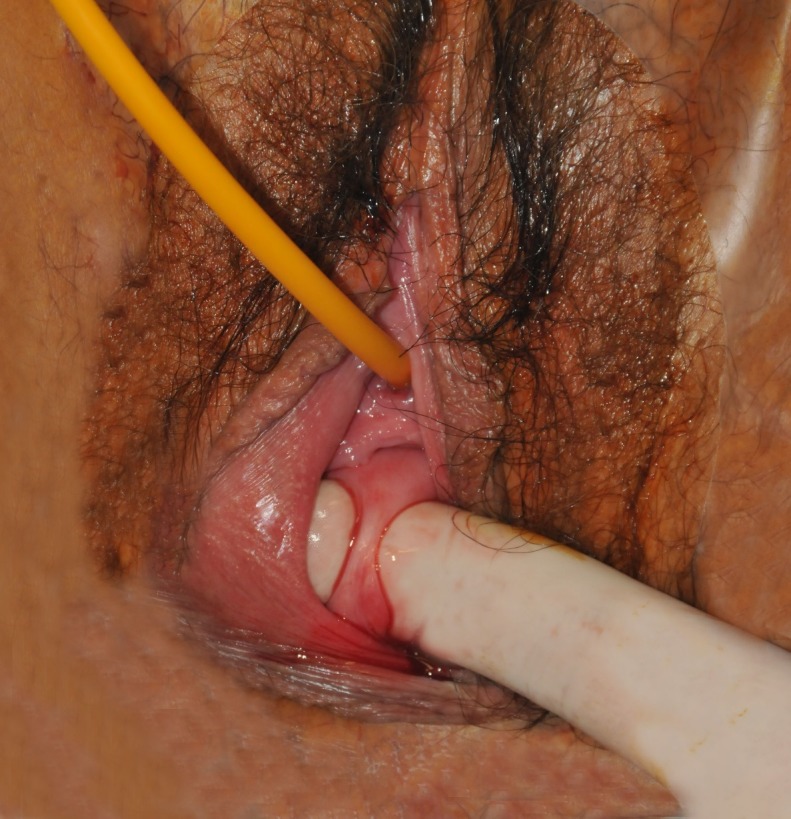The incidence of vaginal band adhesion is unknown, but it has been described after traumatic pelvic injury, transvaginal mesh repair, and in Stevens–Johnson syndrome.1-3 The vaginal band adhesion is a direct effect of the contact between the anterior and posterior vaginal wounds during the healing process. In theory, all vaginal injuries could cause adhesions. There are multiple usual reasons for a vaginal injury; for example, sex, sex toys, insertion of foreign objects (including tampons, pessaries, diaphragms, or dildos), vaginal delivery, instrumental delivery, or falling on an object. Based upon the anamnesis, it is possible to track down most of the causes. However, sometimes the cause remains a mystery. Symptoms of a vaginal band adhesion can be dyspareunia or the inability to use the vagina for installing foreign objects. We report the case of vaginal band adhesion without symptoms.
A 43-year-old woman was referred for the surgical treatment of medical-treatment-resistant menorrhagia. Surgical options, such as endometrium ablation and hysterectomy were discussed. The patient opted for a vaginal hysterectomy. During surgery, one adhesion was seen at the posterior fourchette, and one was seen in the vagina. The latter was previously not noticed during clinical examination. This adhesion was elastic and without stretching it was 10 mm in size. It connected the anterior vaginal wall with the posterior vaginal wall in the middle of the vagina (Figure 1). The adhesion “divided” the vagina into two halves and had the ability to stretch, which was probably due to the elastic structure. The patient did not have dyspareunia and had no problem with tampon use. A speculum examination will miss these lesions, and they can mask mid-vaginal cancer.4 The adhesions were removed by sharp dissection, and the vaginal hysterectomy was performed without complications.
Figure 1. A bridge between the anterior and posterior vaginal wall in the middle of the vagina.

In conclusion, vaginal band adhesions can occur after surgery, trauma, or a mucocutaneous disease. The incidence is probably low due to the regular natural “use” of the vagina. In case of a persistent vaginal band adhesion, a surgical adhesiolysis can be performed. The present case illustrates that a clinical examination should encompass both a speculum examination and an internal digital examination.
Footnotes
How to cite: Tjalma WAA. The vaginal bridge. Autops Case Rep [Internet]. 2019 Jul-Sep; 9(3):e2019093. https://doi.org/10.4322/acr.2019.093
The author retains an informed consent signed by the patient, and the manuscript is in accordance with the Institutional Ethics Committee.
Financial support: None
Reference
- 1.Younes G, Goldschmidt E, Zilberlicht A, Auslender R, Haya N, Abramov Y. Vaginal adhesions after transvaginal pelvic reconstructive surgeries: prevalence and clinical implications. Int Urogynecol J. 2016;27(1):141–145. doi: 10.1007/s00192-015-2807-5. [DOI] [PubMed] [Google Scholar]; Younes G, Goldschmidt E, Zilberlicht A, Auslender R, Haya N, Abramov Y. Vaginal adhesions after transvaginal pelvic reconstructive surgeries: prevalence and clinical implications. Int Urogynecol J. 2016;27(1):141-5. http://dx.doi.org/10.1007/s00192-015-2807-5. PMid:26243182. [DOI] [PubMed]
- 2.Long C-Y, Wu M-P. Dyspareunia caused by a vaginal adhesion band following a transvaginal mesh repair. Gynecol Minim Invasive Ther. 2013;2(3):96–98. doi: 10.1016/j.gmit.2013.05.002. [DOI] [Google Scholar]; Long C-Y, Wu M-P. Dyspareunia caused by a vaginal adhesion band following a transvaginal mesh repair. Gynecol Minim Invasive Ther. 2013;2(3):96-8. http://dx.doi.org/10.1016/j.gmit.2013.05.002.
- 3.Hart R, Minto C, Creighton S. Vaginal adhesions caused by Stevens-Johnson syndrome. J Pediatr Adolesc Gynecol. 2002;15(3):151–152. doi: 10.1016/S1083-3188(02)00146-8. [DOI] [PubMed] [Google Scholar]; Hart R, Minto C, Creighton S. Vaginal adhesions caused by Stevens-Johnson syndrome. J Pediatr Adolesc Gynecol. 2002;15(3):151-2. http://dx.doi.org/10.1016/S1083-3188(02)00146-8. PMid:12106751. [DOI] [PubMed]
- 4.Tjalma WA, Somville J. Fibula metastasis as the presenting feature of vaginal cancer. Eur J Gynaecol Oncol. 2011;32(1):114–116. [PubMed] [Google Scholar]; Tjalma WA, Somville J. Fibula metastasis as the presenting feature of vaginal cancer. Eur J Gynaecol Oncol. 2011;32(1):114-6. PMid:21446341. [PubMed]


